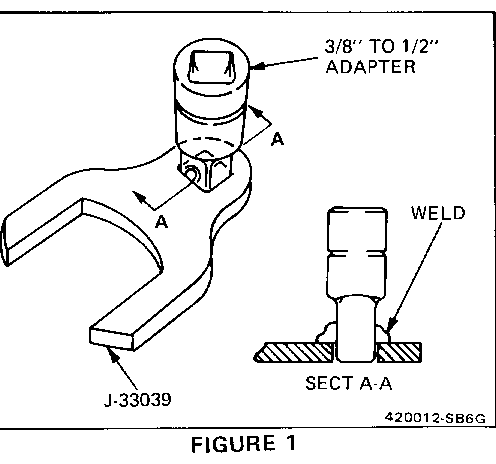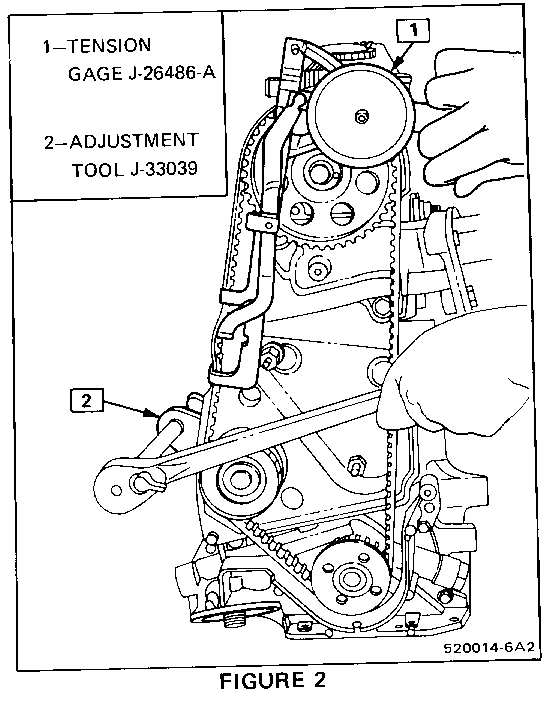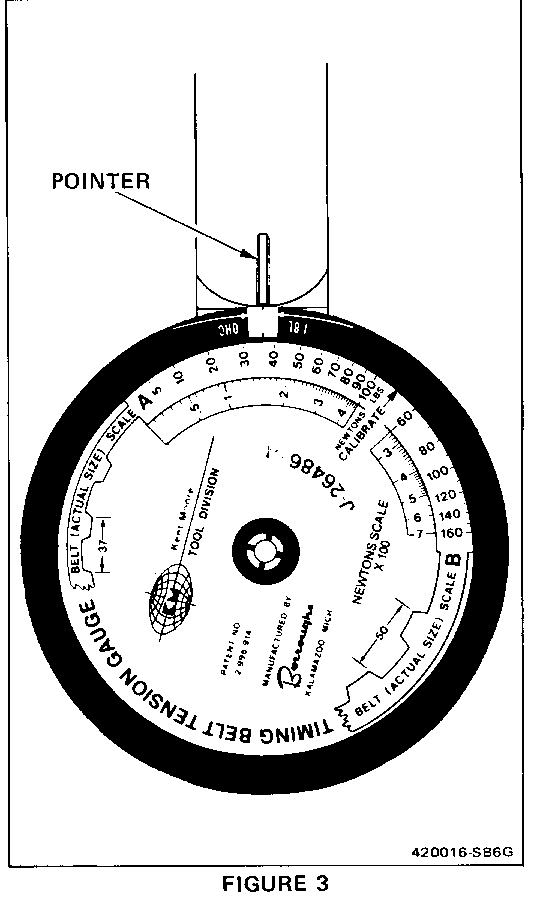TIMING BELT ADJUSTMENT 1.8L OHC 4 - CYLINDERS

Whenever a timing belt is replaced on a 1.8L OHC 4-cylinder engine, it must be adjusted when the engine is at normal operating temperature only (thermostat open).
If a cylinder head is removed and a new head gasket installed before final tension of the belt can be completed, the engine should be warmed-up to normal operating temperature (thermostat open) then retorque the cylinder head in the proper sequence as described in Cylinder Head installation in the appropriate Service Manual.
Tension Specifications Belt Tension With Engine Hot 150N (30 lbs.)
The timing belt tension gage, J-26486-A, was an essential tool included originally in the T1000 tool package which dealers received approximately March, 1981. This same tool was applied to the new 2000 (LH8) engine when it was released. Because of the importance of correct belt tensioning, it is imperative all dealers have a gage which has accurate calibration.
TIMING BELT R&R PROCEDURE
Remove
1. Prep car.
2. Loosen generator pivot bolts.
3. Remove power steering beit (if equipped).
4. Remove two (2) upper timing cover bolts.
5. Disconnect canister purge hose and swing aside.
6. Hoist vehicle.
7. Remove right front wheel.
8. Remove inner splash shield.
9. Remove two (2) lower timing cover bolts, leave cover on.
10. Remove air conditioning belt (if equipped).
11. Remove crankshaft pulley.
12. Lower vehicle to just above floor.
13. Remove timing cover.
14. Remove coolant reservoir.
15. Remove probe holder.
16. Align timing mark on camshaft gear with mark on camshaft carrier.
Important: Do not turn camshaft. Use only crankshaft nut to turn. Turning the nut on the camshaft directly can damage the camshaft bearings.
17. Loosen water pump bolts and remove timing beit (with timing marks aligned).
Install
18. Install new timing belt.
19. Adjust timing belt to specifications using tool J-26486-A. Tool J-33039 is used to adjust the water pump. It can be modified as shown in Figure 1. With gage (tool J-26486-A) installed (Figure 2) tension to within band (between two arrows on perimeter of dial face); identified by 1.8 OHC as shown in Figure 3.
Adjusting the tension with the gage installed on the belt will insure an initial over-tensioning with the new belt.
20. Plug the canister purge hose and run engine above idle for at least three (3) minutes to obtain normal engine operating temperature (upper radiator hose hot).
. As the new belt takes its set position, a substantial tension loss will occur.
21. After belt has been run, recheck tension with gage to within prescribed band on gage.
. If reset of tension is required, it is imperative that gage be removed from belt before the readjustment is performed.
. If gage is left on belt during the reset of tension, the reading will be incorrect. In other words, the gage must not be installed during tensioning due to a possible over-tensioning effect.
. The timing mark on the camshaft year and carrier must be aligned during the final tension recheck or reset.
22. Tighten water pump bolts 24 N.m.
23. Install probe holder.
24. Install timing cover and two upper bolts (not tightened).
25. Raise vehicle.
26. Install crankshaft pulley.
27. Install air conditioning belt (if equipped). Set belt tension to 350 N.
28. Install two (2) lower timing cover bolts and tighten.
29. Install inner splash shield.
30. Install right front wheel.
31. Lower vehicle.
32. Position and connect canister purge hose.
33. Tighten two (2) upper timing cover bolts.
34. Install power steering belt (if equipped). Set tension to 450 N minimum.
35. Tighten generator pivot bolts 33 N.m.
PARTS INFORMATION
Timing belt (Part Number 90122429) is to be obtained from WDDGM.
WARRANTY INFORMATION
LABOR LABOR DESCRIPTION OPERATION HOURS ----------- --------- ----- Replace Timing Belt J0800 1.0 Hr. With A/C Or P/S Add .2 Hr. With A/C & P/S Add .4 Hr.



General Motors bulletins are intended for use by professional technicians, not a "do-it-yourselfer". They are written to inform those technicians of conditions that may occur on some vehicles, or to provide information that could assist in the proper service of a vehicle. Properly trained technicians have the equipment, tools, safety instructions and know-how to do a job properly and safely. If a condition is described, do not assume that the bulletin applies to your vehicle, or that your vehicle will have that condition. See a General Motors dealer servicing your brand of General Motors vehicle for information on whether your vehicle may benefit from the information.
